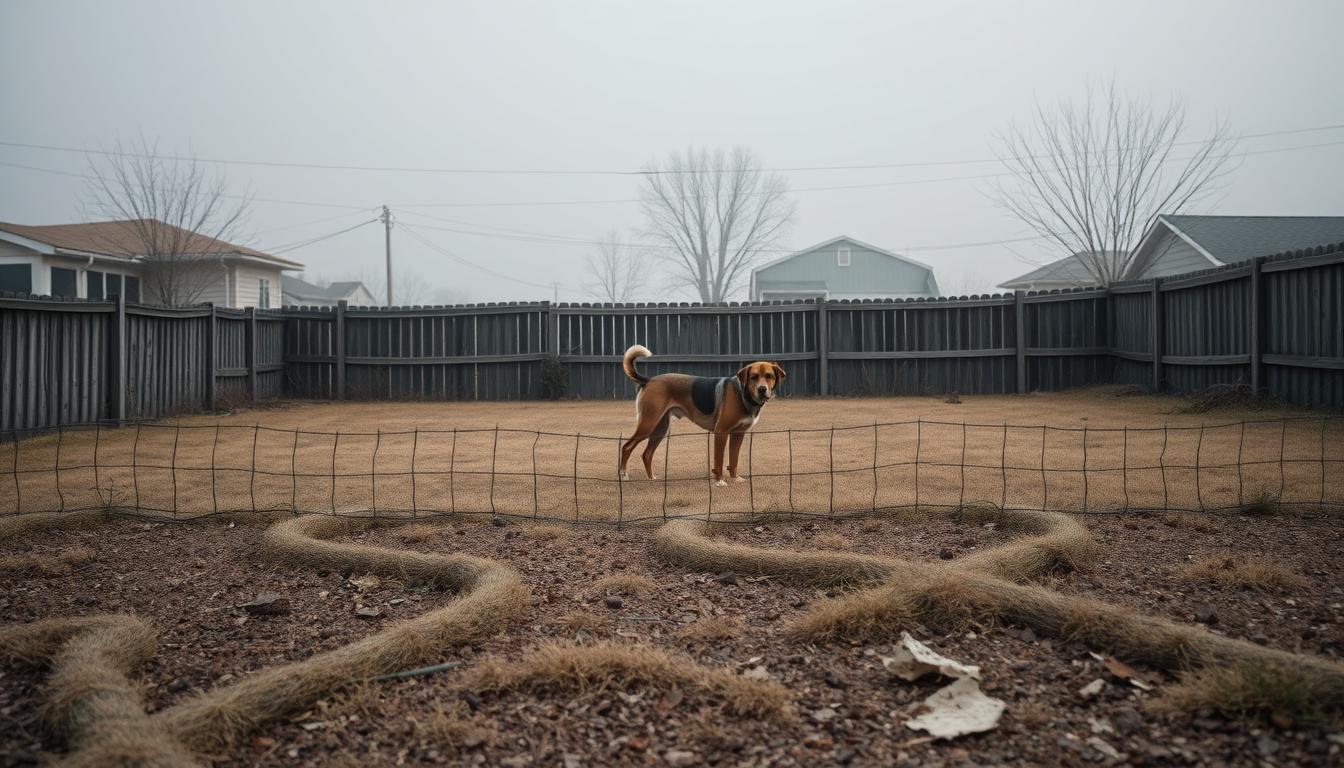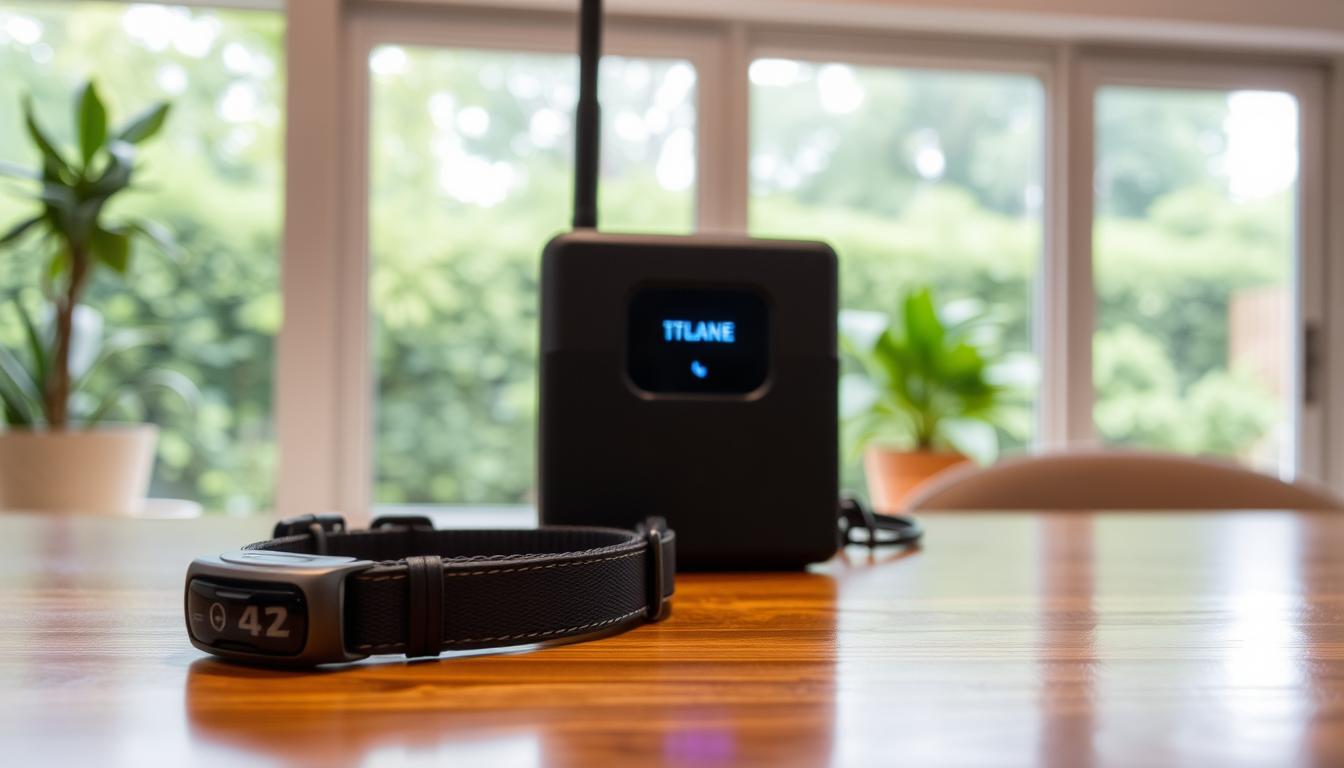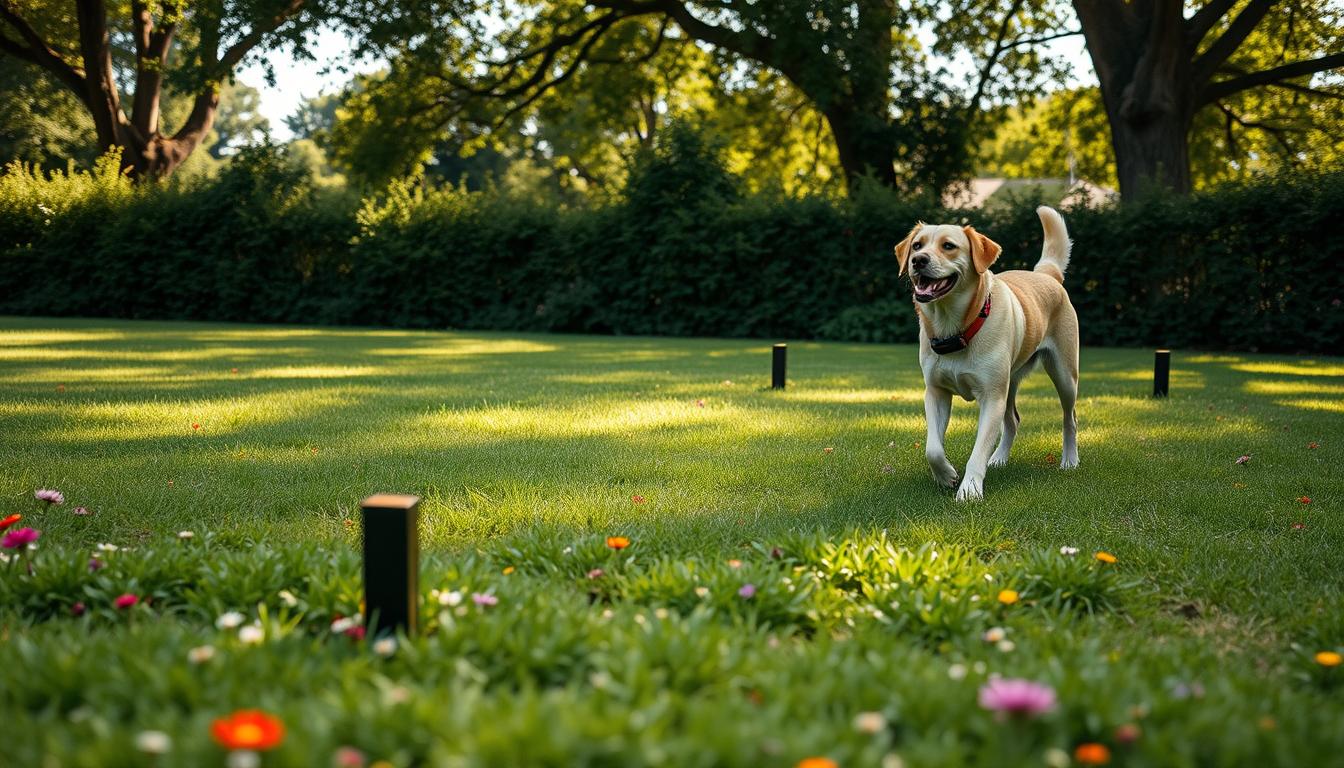As a dog owner, you understand the importance of keeping your pet safe and secure. A wireless dog fence is an effective solution, but it requires regular maintenance to function optimally. Your collar and transmitter are crucial components that need attention to ensure your pet’s safety.
The boundary of your dog fence is only as effective as the system that maintains it. Environmental factors and seasonal changes can impact your wireless dog fence system’s effectiveness. By understanding how to maintain and troubleshoot your system, you can maximize your investment and keep your dog safe.
Key Takeaways
- Regular maintenance is crucial for your wireless dog fence system’s optimal functioning.
- Common issues can be prevented with proper maintenance.
- Identifying when your system needs troubleshooting is essential.
- Proper maintenance extends the longevity of your dog fence components.
- Seasonal changes and environmental factors impact your system’s effectiveness.
Understanding Wireless Dog Fence Systems
A wireless dog fence system is designed to create an invisible boundary around your yard, keeping your dog safe and secure. This system relies on a combination of key components working together to achieve effective containment.
Key Components and How They Work
The primary components of a wireless dog fence include a transmitter, a receiver collar, and sometimes GPS technology. The transmitter sends out a signal that defines the boundary area. The receiver collar, worn by your dog, detects this signal and responds accordingly when your dog approaches the boundary. Modern systems often feature adjustable boundary zones, multiple correction levels, and waterproof components for enhanced reliability.
The technology behind these systems involves radio frequencies or GPS signals to create a containment area. When your dog, wearing the receiver collar, gets too close to the boundary, the collar activates to guide them back, using static correction, vibration, or tone warnings.
Different Types of Wireless Fence Systems
There are several types of wireless dog fence systems available, including GPS-based systems, radar systems, and hybrid systems that combine wireless technology with boundary wires. GPS fencing uses satellites to establish the boundary, while a GPS wireless fence relies on a transmitter for a circular boundary. Wireless underground fences use buried wires for a customized shape.
| Type of System | Description | Key Features |
|---|---|---|
| GPS Fencing | Uses satellites to create a boundary | Flexible boundary, no physical wires |
| GPS Wireless Fence | Relying on a transmitter for a circular boundary | Easy to set up, adjustable radius |
| Wireless Underground Fence | Uses buried wires for a customized boundary shape | Customizable, secure containment |
Each type of wireless fence system has its advantages and limitations, making some more suitable for your property size, terrain, and dog’s temperament than others.
Essential Maintenance Tips for Wireless Fences
To keep your wireless dog fence functioning correctly, regular maintenance is crucial. A well-maintained system ensures your dog’s safety and the effectiveness of the containment.
Regular Inspection Schedule
Establishing a consistent maintenance schedule is vital. You should check the collar fit and functionality weekly and inspect the transmitter monthly. This routine helps identify potential issues before they become major problems.
Transmitter Maintenance
Proper transmitter maintenance is essential for the overall functionality of your wireless dog fence. Check the power connections regularly and ensure the transmitter is placed correctly and protected from environmental damage.
Collar Care and Battery Management
Caring for your dog’s collar is crucial. Regularly clean the contact points, check for wear and tear, and ensure a proper fit. Additionally, manage the battery life by recharging as needed and monitoring low-battery indicators.
By following these maintenance tips, you can ensure the longevity and effectiveness of your wireless dog fence system. Regular checks and proper care will help prevent issues and keep your dog safe.
Common Wireless Dog Fence Issues and Solutions
Common issues with wireless dog fences can be frustrating, but understanding their causes is key to resolving them. Wireless dog fencing systems are designed to provide a safe and effective way to contain your dog, but like any technology, they can sometimes malfunction or present challenges.
Boundary Inconsistency Problems
Boundary inconsistency can be a significant issue with wireless dog fences. This can be due to signal interference, improper transmitter placement, or environmental factors. To resolve this, ensure your transmitter is placed in an optimal location and check for any sources of interference that could be disrupting the signal. Adjusting the transmitter’s position or using a signal booster can help maintain a consistent boundary.

Collar Malfunction Troubleshooting
Collar malfunctions can often be traced back to simple issues such as a loose fit or a dead battery. Ensure the collar is snug on your dog’s neck and check the battery level. If your collar has an LED indicator, test it by pressing the stimulation level adjustment button. If the LED doesn’t light up, it may indicate a battery issue. Regularly cleaning the collar’s contacts and checking for any physical damage can also prevent malfunctions.
Transmitter and Signal Issues
Transmitter and signal issues can significantly impact the effectiveness of your wireless dog fence. Check that the transmitter is receiving power and that it’s properly plugged into a working outlet. If you’re experiencing signal disruptions, look for metal objects or electronic devices that could be causing interference. Repositioning the transmitter or using a different outlet can often resolve these issues. Regular maintenance, such as checking the transmitter’s power source and ensuring it’s free from damage, is crucial.
By addressing these common issues, you can ensure your wireless dog fence continues to function effectively, keeping your dog safe and contained within the designated boundary.
Troubleshooting Dog Behavior with Wireless Fences
Understanding why your dog crosses the boundary despite corrections is key to reinforcing effective boundary training. It’s crucial to assess both the technical and behavioral aspects to ensure your wireless dog fence works as intended.
When Your Dog Crosses Boundaries
If your dog continues to cross the boundary, it may be due to confusion or a lack of understanding of the fence system. To address this, revisit your training approach. Ensure you’ve marked the boundary clearly with training flags and walked your dog around the perimeter on a leash, reinforcing good behavior with treats and praise.

Addressing Fear or Confusion
Some dogs may develop fear or confusion due to the corrections from the collar. To address this, introduce corrections gradually and use positive reinforcement. If your dog shows signs of anxiety or aggression, adjust the correction levels based on their temperament and response.
- Identify if your dog is confused or testing the boundaries.
- Use desensitization methods and positive reinforcement.
- Adjust correction levels according to your dog’s response.
Seasonal Maintenance for Wireless Dog Fences
Seasonal changes can significantly impact the performance of your wireless dog fence system. To ensure consistent effectiveness, it’s crucial to adjust your maintenance routine according to the time of year.
Winter Care Tips
In winter, extreme cold and snow can affect your wireless dog fence’s performance. To maintain functionality, check your collar and battery regularly, as cold weather can drain batteries faster. Ensure the transmitter is protected from freezing temperatures and snow accumulation, which can impact signal strength. You may need to adjust the fence boundary to account for snow-covered areas.
Summer Maintenance Considerations
During summer, heat and humidity can affect electronic components. Check your wireless dog fence system’s system for any signs of damage or wear. Adjust the collar fit as needed due to your dog’s seasonal coat changes. Regularly inspect the fence boundary to ensure it’s not overgrown with vegetation, which can interfere with the signal.
When to Replace Components vs. Repair
Knowing when to repair versus replace components of your wireless dog fence is essential for its continued functionality. The decision to repair or replace depends on several factors, including the type of issue, the age of the component, and the cost of replacement.
Signs Your Collar Needs Replacement
If your dog’s collar is no longer functioning correctly, it may be time to replace it. Signs that your collar needs replacement include a consistent lack of static stimulation, visible damage, and frequent malfunctions. When selecting a new collar, consider factors such as compatibility, size adjustability, and battery life.
| Signs of Collar Failure | Description | Recommended Action |
|---|---|---|
| Lack of Static Stimulation | No correction when dog approaches boundary | Check battery, adjust settings, or replace collar |
| Visible Damage | Cracks, wear, or corrosion on the collar | Replace collar to ensure functionality |
| Frequent Malfunctions | Intermittent issues that persist after troubleshooting | Replace collar for reliable performance |
Transmitter Replacement Guidelines
The transmitter is a critical component of your wireless dog fence system. If you experience frequent signal drops, inability to hold settings, or physical damage to the transmitter, it may be time to replace it. When selecting a new transmitter, ensure it’s compatible with your existing system and consider factors like signal strength and adjustability.
Professional vs. DIY Repairs
When it comes to repairing your wireless dog fence, you must decide between DIY repairs and professional service. While DIY repairs can be cost-effective for simple issues, complex problems may require professional expertise. Consider factors like warranty coverage, component age, and availability of replacement parts when making your decision.
Conclusion: Keeping Your Wireless Fence System Reliable
To keep your wireless dog fence functioning optimally, regular maintenance is key. By implementing a routine that includes regular testing, component care, and boundary checks, you can ensure the long-term reliability of your wireless dog fence system. A proactive maintenance approach not only prevents common issues but also extends the life of your investment, keeping your dog safely contained within the designated area.
Creating a comprehensive maintenance calendar that incorporates daily, weekly, monthly, and seasonal tasks will help keep your fence system in optimal condition. Balancing proper system maintenance with effective dog training is also crucial for a harmonious containment solution. Remember to keep product manuals and troubleshooting guides accessible for quick reference when issues arise.
As your dog ages or you add more dogs to your household, adapting your maintenance routine is essential. By doing so, you’ll not only ensure your dog’s safety but also gain peace of mind knowing your wireless containment solution works reliably when you need it most.
FAQ
How often should I inspect my wireless dog containment system?
You should inspect your system regularly, ideally every few months, to ensure it’s functioning correctly and make any necessary adjustments.
What are the signs that my dog’s collar needs replacement?
If your dog’s collar is not responding to the boundary warnings, or if the battery life is significantly reduced, it may be time to consider replacing the collar.
Can I use my wireless dog fence system in extreme weather conditions?
Most systems are designed to work in various weather conditions, but it’s essential to check the manufacturer’s guidelines for specific temperature and weather ranges.
How do I know if my transmitter is working correctly?
Check the transmitter’s signal strength and ensure it’s not obstructed by objects or other devices. You can also consult the user manual for troubleshooting guides.
What should I do if my dog crosses the boundary despite the warnings?
If your dog continues to cross the boundary, review your training procedures and adjust the warning levels or vibration settings as needed to effectively deter your dog.
Are there any specific GPS or containment system requirements I should be aware of?
Familiarize yourself with the system’s GPS capabilities and containment features to ensure you’re using it effectively and making the most of its functionality.
Can I repair my wireless dog fence system myself, or do I need professional help?
For minor issues, you can try troubleshooting and repairing the system yourself, but for more complex problems, it’s recommended to consult a professional to avoid causing further damage.
How do I properly care for my dog’s collar to extend its battery life?
Regularly clean the collar, avoid exposing it to extreme temperatures, and follow the manufacturer’s guidelines for battery replacement to maximize its lifespan.





